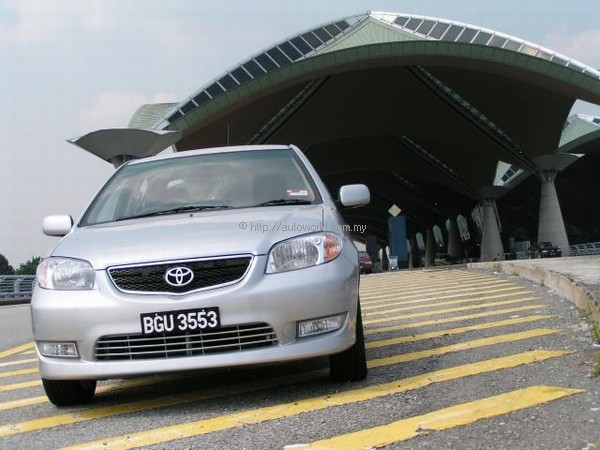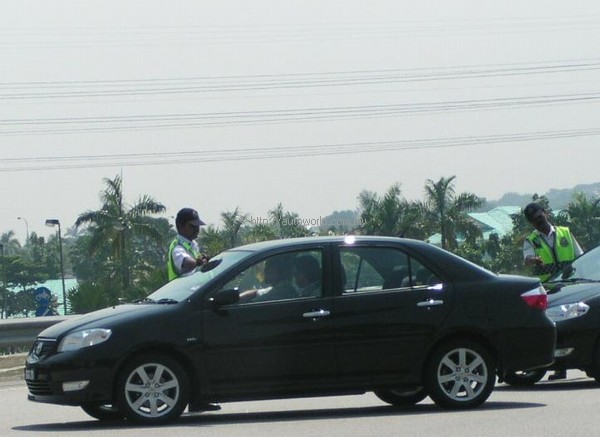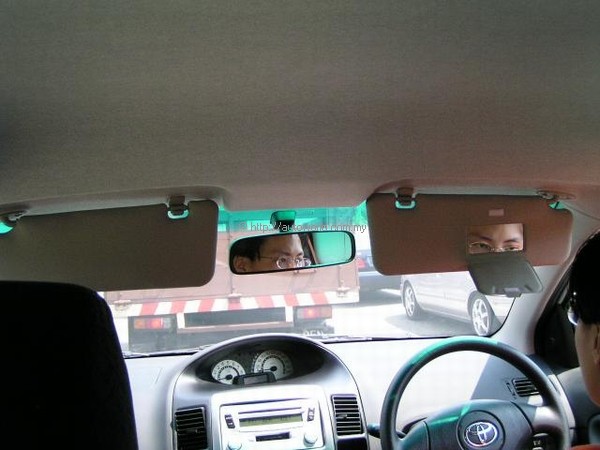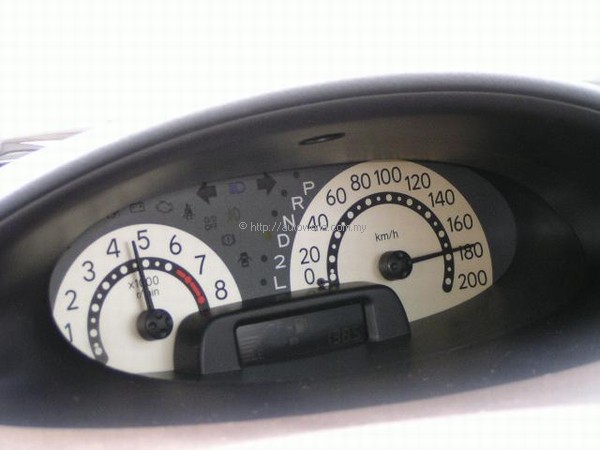Driving impressions: Toyota Vios 1.5G
If evidence of the power of the new Toyota Vios was needed, it came to four journalists very quickly: just minutes after departing from the starting point, they were zapped in a speedtrap at Subang and two policemen became the first in Malaysia to issue summonses for the Toyota Vios! Perhaps from a corporate point of view, having its latest model (which has not even been officially launched) being pulled over to be issued a speeding ticket isn’t something to shout about but a good PR person could exploit this sort of incident too…
Of course, even before getting behind the wheel of the Vios, everyone already knew that it would be a powerful car, especially with the VVT-i engine developing 80 kW. That’s a lot for car that weighs less than 1000 kgs at the kerb. Furthermore, it’s a 1.5-litre engine and that too is something, because back in the early 1980s, my Toyota Levin coupe had a 2T-G twincam EFI engine which was considered the ‘hot engine’ of that time and it was putting out 81 kW… amazing how much technology has advanced.
For this first test-drive session of the Vios, UMWT picked a route from Sunway in Petaling Jaya to Seremban and back, about 150 kms in all. The silver car allocated to me had about 600 kms on the clock so the engine was still a bit new but as I would discover, that didn’t make much difference to the performance.
As I accelerated off, the first impression was “this feels just like a Toyota” and that means that the engine had the same muscular character as the ZZ engine in the Corolla Altis. It also had that robust feel to it, solid and refined, with a smooth delivery of power. From the way it surged forward, I was already pretty sure that this would be a car enthusiasts would appreciate.
 |
Fortunately for me, a last-minute no-show by one of the journalists meant that I had a UMWT guy as my partner for the drive and I say fortunately not just because I could drive both ways but also because he got a call from one of his colleagues ahead that there was a speedtrap! By then, all the cars had moved off so there was no way to let the other drivers know and a couple got caught.
Hitting the highway to KLIA, I found the acceleration very strong and the engine noise level low as I merged with traffic. The good sound insulation made the speed deceptive and 110 km/h didn’t feel or sound like it. Wind noise too was muted enough for a conversation at a normal volume, something which you can’t do in some small cars and I would add that the blower noise was impressively low as well.
Along the way, I was guided to Ladang Tihsllub where UMWT has this secret test course with a straight that is 5 kms long. It was here that I redlined the engine and in top gear (overdrive ratio of 0.70:1), the tachometer needle stopped at 4600 rpm and the car was rocketing along at 178 km/h. That was certainly very impressive for a 1.5-litre sedan and the car felt rock-steady at that speed. It could probably do 180 km/h with a bit more mileage and in fact, Chris Wee of AUTOCAR ASEAN said he saw the needle at 190 km/h! (Ladang Tihsllub…yeah, right, you must be saying, but you don’t expect me to declare here that I exceeded the national speed limit on a public road, do you?).
Having established that impressive straightline performance, I then moved on to seeing how handling would be. It is, in a word, predictable and well matched to the sort of power the engine has. The car tracks obediently through curves and bumps don’t affect it at all. The degree of compliance in the suspension is good and the rear wheels, in particular, stay glued to the road.
As for ride comfort, the long wheelbase does contribute to nice and stable progress. Bumps can be felt but in most cases, the shocks don’t actually reach your body. They disappear somewhere inside the generous padding of the seats.
I can’t tell you much about the ABS since there were no opportunities to use it but I am sure it works as advertised. The brake feel is firm and progressive, with a medium amount of travel for the pedal.
Looking over the Vios in other aspects, the first thing was the feeling under my right foot. There’s some sort of protrusion just where the heel is and it felt irritating. I was told that it is meant to help the foot when it is operating the accelerator pedal but it sure felt odd. There is no footrest for the left foot but this may not be all that necessary since the floor curves up and you can still relax your foot on the curved section.
The steering wheel, a 3-spoke affair, has a nice sporty look and feel with large stalk controls on either side of the adjustable steering column. Toyota designers have long mastered the art of making things feel refined and the operation of the stalks and switches all have that high quality to them. The only thing that I feel needs improvement is the horn which is rather weak and not in keeping with the rest of the car’s image. Surely a better horn will not bump up the price that much?
The absence of the instrument panel ahead of the steering wheel did feel odd at first but I guess an owner will get used to it. The centre-mounted instrument panel is really quite convenient to use and although I thought that I might be turning my head too much, in practice, it seemed like my eyes shifted more than my head. The whole panel is well shrouded and there were no unpleasant reflections. However, at certain times of the day, the metallic trim panel could cause an irritating glare as bright sunshine bounces off its surface.
Like the City, the Vios instrument panel has no coolant temperature gauge. It seems like the Japanese consider this item redundant since most people do not look at it. Instead, there are two warning lights – one for a cold engine and the other for an overheating condition. As I argued in my report on the City, there is still a need for a gauge because a driver can see when the engine coolant temperature is rising – rather than when a red light comes on and the car has to be stopped immediately. And furthermore, the red warning light is the furthest one from the driver’s eyes and the intensity and size may not be enough to attract attention at a crucial moment.
From our forum discussions, it seems that there are quite a number of people who would like the digital-graphic display that is available in some countries. However, product planners at UMWT felt that more would prefer the conventional analogue meters so that’s what they have put in. Personally, I like analogue meters too (and I don’t use digital watches either) but I can understand that the new generation of younger customers who have grown up in the PC and Star Wars age relate comfortably to digi-graphic displays. They look at these differently from older motorists and so it may be a good idea to provide this as well.
The two recesses on either side of the centre console panel of the dashboard are useful but I found that they do not have sufficient depth to fully hold a tollcard or a phone. The phone can, however, be slotted into a narrow tray by the side of the handbrake lever. As for the cupholders, these are too shallow and even 500 ml containers may tip over. For cupholders to be effective, they need to be deep enough.
One thing that irritated me was the position of the air vent nearest the steering wheel. It is at the point where it just blows cold air onto the hands and no matter how you adjust its direction and the angle of the vents, there is still cold air blowing onto the hand. You may consider this a small thing but if you are driving a hundred kms with that cold air blowing against your left hand, you may think differently!
On the return journey, I spent time in the back seat to check out the comfort. Though the backrest appears rather upright, it is actually not uncomfortable and headroom is also pretty good. With the front seat pushed all the way back, there is still reasonable legroom too.
Of the dark upholstery, I must say it’s not as black as I had imagined (the first and only time I saw a Vios till now was at night) and is really a dark grey. Not too bad, really, and from the maintenance point of view, dirt would show up less than with a light-coloured material.
VIOS versus CITY
It used to be that Toyota’s arch-rival was Nissan and the battle was always between the Corolla and the 120Y/130Y/Sunny. In 2003, it’s Toyota versus Honda, the Vios versus the City.
The design concepts for these two cars show different approaches to meeting the requirement for a small, affordable sedan. The Vios appears to be oriented towards younger buyers who are enthusiasts and to whom performance would be a high priority. With the City, the approach taken has been to offer practicality, also desired by some kinds of buyers.
With the clear difference in engine outputs, it is obvious that the Vios has the edge when it comes to straightline performance. It’s an exhilarating car to drive and it has competent handling. On the other hand, the City can also offer pleasurable motoring and it has the added appeal of the 7-speed Steermatic CVT plus the versatility of the ULTra seat in the back.
So it all depends on what matters to you more: performance or practicality. Both these cars are well engineered and fine cars, no doubt about it. They are from companies which have a long and proven reputation for making reliable and durable cars. Just as you can’t go wrong picking an IBM computer for your company, you won’t go wrong picking either a Toyota or Honda.
If you were expecting me to state one or the other, I’m sorry if I have not. The reality of it is that there will be people who will consider rear accommodations and cabin versatility as irrelevant since they don’t have a family yet and all they really want is a fast car – and there will be others – perhaps older drivers like me – who don’t have that ‘Fast and Furious’ urge any longer and who want practical transport (and who get seduced by that Steermatic feature!).
 |





























